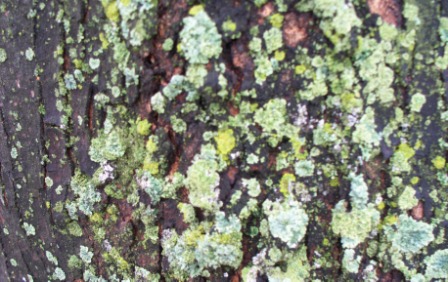We often hear that the US needs to boost its investment in science education to keep up with rest of the world. While we often think in terms of physics and chemistry when we think of science, we need to remember biology and ecology fit in the mix, too.
I bring this up because of a call a received a while back from a homeowner. The gentleman was concerned /borderline distraught that he would have to remove a prized maple tree from his front yard because it had “peculiar growths all over the trunk”. I told him it was difficult to diagnose a tree problem sight unseen but if he could send me some images, it might help me out.
The photo did indeed make ‘the problem’ obvious.

The growths were lichens. Lichens do not harm trees but I’m sure an unscrupulous tree service could have easily convinced the homeowner his tree needed come out had he not contacted me first. Lichens are actually two organisms; a fungus and an algae that form a symbiotic relationship and function very much like one organism The algae part of the lichen is photosynthetic, and therefore they are able to produce their own energy and do not take any resources away from the tree. In fact, lichens often grow on non-living substrates such as wood, concrete, tombstones, benches and so on. If a homeowner observes a dead tree or dead branch covered with lichens on it, this is a coincidence; the lichens did not cause the branch or the tree to fail. The tree trunk or branch simply provides a porous surface for the lichen to attach. Lichens are often fairly inconspicuous, but in some moist areas, such as the Pacific Northwest, they may form a mat that completely coats branches.
Fast facts about lichens
Lichens grow in some of the most inhospitable places on earth from deserts to tundras.
Lichens are commonly grayish-green, but may also be yellow or red, depending of the type of algae associated with the fungus.
Lichens are sensitive to air pollution, and researchers are investigating their use as a bio-indicator of air pollutants such as sulfur dioxide and ozone.
Lichens are fascinating organisms, if you are taking a liking to lichens try these websites:
http://www.nmnh.si.edu/botany/projects/lichens/
http://www.ucmp.berkeley.edu/fungi/lichens/lichens.html
There’s something fundamentally comforting about lichens. I have the sense that if the rest of the plant world were somehow to vanish, all those primitive plants like lichens and mosses and saprophytes and bryophytes would still remain, and repopulate (rehortulate?) the planet.
Bert,
I once heard something that was either crazy or true, and I hope you can tell which it is: I was told that lichens only attach to a tree or branch that has stopped growing. If the tree or branch were still growing, it would expand and lichens don’t like that.
I made a mental note to confirm this with someone who knows something about lichens and trees.
This reminds me of the following true story from my days as a Cooperative Extension Agent here in Syracuse, New York . . . . . one day an elderly couple came to our office with a large plastic bag filled with bark from what appeared to be a honeylocust tree. They had scraped off “as much as they could reach” because they were afraid the “disease” it had contracted was going to kill it, and spread to other plants in their landscape. Needless to say, they were not too happy when I explained to them that the “disease” was nothing more than harmless colonies of lichens – but . . . , they had quite possibly killed their tree by scrapping off so much bark right down to the cambium! Also, for SteveA . . . . , lichens do colonize “growing” tree trunks, branches and stems.
Last year, I had a woman insisting the mold on her tree was killing her. All it was was lichen. I could not convince her because she read it on the internet. http://www.avoid-nasal-allergies.com/fall-allergies.html Luckily, the city administration took my side.
I just did a site visit to see what was wrong with a garden, only to discover that the new home owner used Deck & Tile-Mildew cleaner on all the lichen encrusted trunks of oaks and maples “to get rid of the mold”… the bleach smell still made my eyes water even though they had “cleaned up” a week previous. Alas it looks like they have burned most of their very expensive garden as well as killed the grass.(Not that I support having Lawns in California). Sigh. “The label said it would clean mold off wood surfaces…”